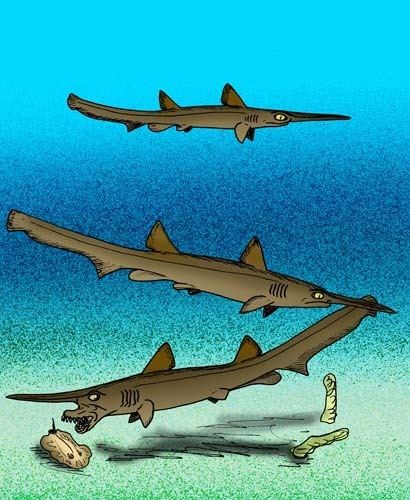Overlies Dzheirantui Formation | Underlies Aitym Formation Region Asia | |
 | ||
The Bissekty Formation (sometimes referred to as Bissekt) is situated in the Kyzyl Kum desert of Uzbekistan, and dates from the late Cretaceous Period. Laid down in the early the Turonian to Coniacian stages, it is dated to about 90-85 ma (million years ago).
Contents
- Invertebrate paleofauna
- Molluscs
- Vertebrate paleofauna
- Amphibians
- Lizards
- Ray finned fish
- Theropods
- Turtles
- References
The Bissekty Formation is characterised by a mix of marine, brackish, freshwater, and terrestrial animal fossils. This stands in contrast the strictly marine fossils found in the underlying Dzheirantui Formation, and indicates that the Bissekty was formed during the regression of a saltwater sea. The coastline expanded inland again in the upper portion of the Bissekty, represented by a proportional increase of fully aquatic species, which were almost completely absent from the middle period of the formation. Semi-aquatic species remained abundant during this middle period, and the geology of the formations indicates that a braided river system took the place of the coastline. Eventually the area was again completely underwater, during the time period represented by the later Aitym Formation, which preserves coastal marine sediments.
Invertebrate paleofauna
An indeterminate species of marine coral.
Molluscs
An indeterminate species of marine placenticeratid ammonite. An indeterminate species of marine teredinid shipworm. An indeterminate marine trigoniid bivalve. An indeterminate marine veneroid bivalve.
Vertebrate paleofauna
The Bissekty Formation is notable for preserving the most abundant Turonian land animal fossils in Eurasia, and the most diverse fauna of Late Cretaceous eutherians (placental mammals and relatives) in the world.
Listings and accompanying information are based on a survey of the Bissekty Formation published by Cory Redman and Lindsey Leighton in 2009 unless otherwise noted. Aquatic and semi-aquatic species are restricted to freshwater unless otherwise noted.
Amphibians
An indeterminate species of salamander-like albanerpetontid amphibian. An indeterminate gobiatid species.
Lizards
An indeterminate gekkonid. An indeterminate priscagamid. An indeterminate scincid.
Ray-finned fish
An indeterminate acipenserid. An indeterminate albulid (bonefish) species. An indeterminate albulid (bonefish) species. An indeterminate pholidophoriform species.
Theropods
An unnamed ornithomimosaur, known from fragmentary remains. An indeterminate tyrannosaurid species, known from isolated teeth.
Turtles
An indeterminate trionychid (soft-shell) turtle species that was tolerant of brackish water.
